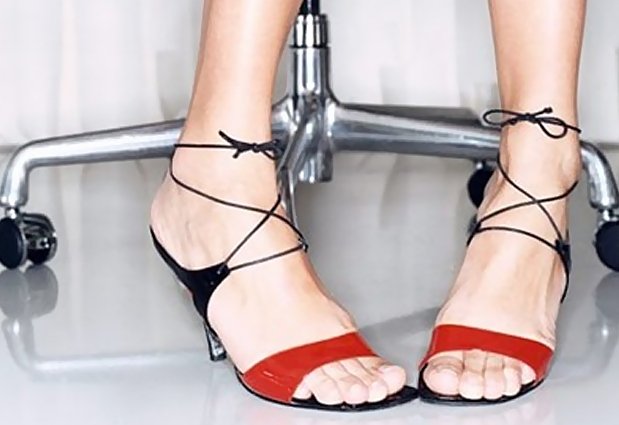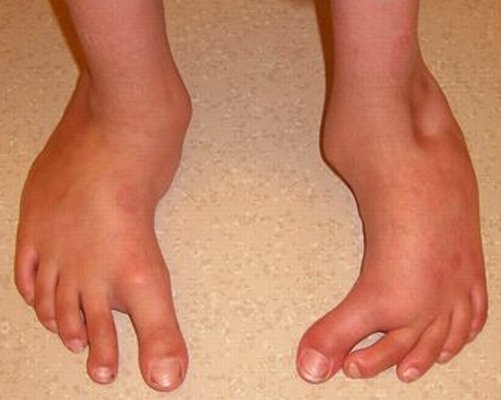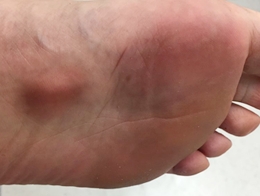Pigeon Toed
What does pigeon toed mean? Get more insights on various symptoms and causes of pigeon toes in toddlers, and information about how to correct pigeon toes.

My toddler has pigeon toes (curved feet with toes pointing inwards), is it something to be worried about?
The foot is a very strong and complex structure with as many as 26 bones and 33 actively articulated joints held together by muscles, tendons and ligaments. A toddler’s foot is highly flexible as it is stuffed with fats. It is a very common and endearing sight to see an 8- 15 month old toddler struggling to walk with his or her knees and toes pointing inwards. In the initial stages, the toddler’s feet point inwards because the muscles and ligaments are yet to be developed. However, if the toddler’s knees and toe do not straighten by the age of 3 years, the parents tend to get perturbed.
Pigeon toe (medically called in-toeing) is a term used to describe a condition in which a person’s toes point inwards while walking. Pigeon toe is commonly observed in toddlers. In most cases, pigeon toe in toddlers is not really a matter of concern as the toddler gains the normal gait before reaching adulthood.
However, it is a good idea to discuss any abnormality in your child’s gait with the paediatrician. Pigeon toe is generally not associated with any pain or inconvenience in toddlers, neither is it known to cause any serious medical conditions like arthritis. It does not hinder physical activities like walking or running. In fact, it is believed that people who are pigeon toed tend to be good runners or athletes. However, it should be noted that severe cases of pigeon toe can give rise to a condition called club foot. In some children pigeon toes may be observed as a result of pre-existing medical conditions such as cerebral palsy.
What are the Symptoms of Pigeon toes?
The symptoms of being pigeon toed include feet pointing inwards, twisted shin or thighbone clumsiness while walking and stumbling which occur in severe cases. People with pigeon toes tend to suffer from hip, knee or ankle injuries at later stages of life.
What Causes Pigeon toe?

While pigeon toe may be caused due to genetic predisposition, most of the cases occur due to misalignment occurring due to squeezed- up position of the baby in the mother’s womb.
Metatarsus adductus is a condition in which the outer edge of the foot has an inward curve, giving a kidney like appearance to the foot. Metatarsus adductus is very commonly observed in newborn children. It most commonly occurs due to the position of the child in the womb during pregnancy.
It is often observed in children who like to sleep with their face down. These children are more susceptible to dysplasia of hip, a condition in which the top of the thigh slips within or outside the socket. Metatarsus adductus is classified into two types – flexible (the foot can be straightened to a certain degree by massaging or bending with hand) and non-flexible (the foot cannot be straightened by any amount of massaging with hand). Generally flexible form of pigeon toe corrects itself as the baby grows without any treatment.
Sometimes, an inward twist of the tibia or shin bone is observed. Like metatarsus adductus, the twist in shin bone may also be caused due to the position in which the baby lays in the mother’s womb. This condition is most commonly observed in children learning to walk. In most of the cases, the shin bone slowly untwists and the leg straightens out by the time the child turns one year old. However, surgery may be required if this condition persists above the age of ten. Children who are pigeon toed and trip often may have internal tibial torsion.
In some cases it is seen that the knee caps tend to point inwards when the child is walking. This condition is caused due to femoral anteversion or an inward twist in the upper thighbone. Toddlers with femoral anteversion can be identified by their unique affinity to sit with their legs in ‘W’ position. It is always advisable to discourage your toddler from sitting in the ‘W’ position so as to avoid worsening of the femoral twist. Femoral twist is more commonly observed in girls than in boys. Most children outgrow this condition by the age of eight to ten years. However, in some children complete untwisting of the thighbone does not occur. Most of the cases of pigeon toes occurring in adults are due to femoral anteversion.
Pigeon toes Treatment
It is common to notice some extent of in-toeing in infants up to the age of two or three. This in-toeing is observed as a result of differences in the structure of the child’s foot. As the child’s age increases, their gait begins to improve without any particular treatment. However, if this does not happen by the age of three, a physician or a podiatrist should be consulted to make sure that the child’s bone development is taking place correctly. Most cases of metatarsus adductus are diagnosed in infancy when developmental changes in the child’s foot are still going on.
Exercises
The physician may ask you to perform some passive manipulation exercises on your child’s feet while bathing or changing his diapers. A change in the sleeping position of the child, for instance side- lying position, may help.
If the foot does not respond to any amount of stretching or exercise, long leg casts, braces or splints may be used, which have to be changed every 1 to 2 weeks. If improvement in in-toeing is seen with the use of leg cast, the use of straight cast shoes may be prescribed. Straight cast shoes are made without an arch in the bottom and help to hold the forefoot in place. There is a difference in opinion amongst physicians regarding the use of braces for correction of pigeon toes. While some doctors feel that pigeon toes can be corrected by using braces when the child is 4- 6 months old, others feel that use of braces speeds up the development of pigeon toes, thereby worsening the alignment of the toes.
Surgery
In very severe cases of pigeon toes, surgery may be required to correct the condition. Most of the time, surgery involves strengthening of the achilles tendon. Leg casts may be used post-surgery to hold the foot in place.
Proper Shoes
The shoes that your child wears play an important role in shaping the child’s gait. A child gains meaningful sensory information from the soles of their feet. Shoes that have hard soles may make walking difficult. Toddlers should be allowed to walk barefoot and shoes should be used only to protect their feet from injury due to sharp objects. In order to prevent worsening of pigeon toe, the child should be discouraged from crossing his or her legs while sitting. Regular use of corrective shoes, splints or cast should be encouraged. Ballet, which is a dance form, has been used to improve the symptoms of pigeon toe.
Do not allow your child to sleep on his or her tummy with feet curved under the stomach, in the position similar to which the baby sleeps in the womb. This sleeping position worsens the in toeing. Encourage your baby to sleep on his or her back or side.
Moreover, do not allow your toddlers to sit with their feet bent beneath their bottoms. Stretching their legs gently while massaging helps in proper development of toes and leg muscles. If your baby trips a lot while walking, do not forget to mention it to the paediatrician during the next visit.
If your child is above 10 years of age and has a pigeon toe with very little possibility of being corrected, do not get discouraged. Remember that many gifted athletes are pigeon toed. In fact many football, basketball, soccer and track coaches want pigeon toed players to join their club. It is important to bear in mind that pigeon toe does not affect your child’s ability to walk, run, swim or participate in any sports activity. At any time seek medical help if your child is facing trouble in walking, running or complains of excessive pain in the legs.





